What is a Prokaryotic Cell?
- Prokaryotic cells, as delineated in the realm of cellular biology, represent a fundamental and ancient category of cellular life forms characterized by their stark deviation from the eukaryotic paradigm. These cells are conspicuously bereft of a genuine nucleus, as well as the suite of membrane-bound organelles that typify the eukaryotic cell.
- The term “prokaryote” derives from the Greek words “pro,” signifying “before,” and “karyon,” denoting “nut” or “kernel.” This etymological derivation aptly captures the primitive essence of prokaryotic cells. In early biological classifications, prokaryotes found their place within the empire Prokaryota, a categorization conceived by Édouard Chatton.
- However, in the contemporary three-domain system, rooted in molecular analyses, prokaryotes assume a dualistic partitioning into two distinct domains: Bacteria (formerly Eubacteria) and Archaea (formerly Archaebacteria). Organisms bearing the hallmark of nuclei are relegated to a distinct realm known as Eukaryota. Remarkably, prokaryotic life forms predicated the emergence of their eukaryotic counterparts.
- Beyond the conspicuous absence of a bona fide nucleus, prokaryotic cells further eschew the possession of mitochondria and most other membrane-bound organelles that embellish the eukaryotic cellular landscape. In bygone eras, the intracellular constituents of prokaryotic cells were surmised to roam unfettered within the cytoplasm, encapsulated solely by an outer cell membrane.
- Recent revelations, however, have unveiled the existence of bacterial microcompartments, which are postulated to represent rudimentary organelles ensconced within proteinaceous shells, alongside an array of other prokaryotic organelles. Notably, despite their unicellular nature, certain prokaryotes, such as cyanobacteria, are predisposed to the formation of extensive colonies.
- Meanwhile, myxobacteria exhibit multicellular stages in their life cycles. Prokaryotes embrace a mode of asexual reproduction, obviating the fusion of gametes, though horizontal gene transfer remains a plausible avenue for genetic material exchange.
- Molecular elucidations have provided valuable insights into the evolutionary interconnectedness of the three domains of life. The dichotomy between prokaryotes and eukaryotes epitomizes the profound divergence in cellular organization.
- Exclusive to eukaryotic cells is the presence of a delimited nucleus harboring chromosomal DNA, along with an assortment of characteristic membrane-bound organelles, including mitochondria. Within the realm of prokaryotes, a spectrum of distinctive types is discernible, featuring extremophiles and methanogens that flourish in extreme ecological niches.
- In summation, a prokaryotic cell is a form of cellular entity characterized by the conspicuous absence of a bona fide nucleus and membrane-bound organelles. Organisms domiciled within the domains Bacteria and Archaea exemplify the prokaryotic cellular archetype, while the remainder of life’s diversity embraces the eukaryotic paradigm.
- Despite their unicellular constitution, prokaryotes occupy a substantial fraction of Earth’s biological milieu, fostering a diverse array of life forms that continue to shape our planet’s ecosystems.
Prokaryotic cells Definition
Prokaryotic cells are simple, single-celled organisms lacking a true nucleus and membrane-bound organelles.
More definitions of Prokaryotic cells:
- Prokaryotic cells are unicellular organisms with a primitive cellular structure that lacks a distinct nucleus and membrane-bound organelles.
- Prokaryotes are single-celled life forms characterized by the absence of a well-defined nucleus and organelles enclosed in membranes.
- Prokaryotic organisms represent a category of simple cells without a true nucleus, commonly found in domains Bacteria and Archaea.
- Prokaryotic cells are basic, microscopic units of life with genetic material dispersed throughout the cytoplasm, distinct from the more complex eukaryotic cells.
- Prokaryotes are the most ancient and structurally uncomplicated cells, devoid of a nucleus or internal compartments found in eukaryotic cells.
Prokaryotic cells Characteristics
Prokaryotic cells, constituting a fundamental branch of cellular life, are distinguished by a set of characteristic features that set them apart from their eukaryotic counterparts. These defining traits are elucidated as follows:
- Lack of Nuclear Membrane: One of the most salient characteristics of prokaryotic cells is the absence of a well-defined nuclear membrane. Unlike eukaryotes, whose genetic material is neatly enclosed within a nucleus, prokaryotes harbor their genetic material in the form of a single, circular chromosome dispersed freely within the cytoplasm.
- Absence of Membrane-Bound Organelles: Prokaryotic cells lack membrane-bound organelles such as mitochondria, Golgi bodies, chloroplasts, and lysosomes. These cellular compartments, commonplace in eukaryotic cells, play pivotal roles in various cellular functions, but their counterparts are conspicuously absent in prokaryotes.
- Genetic Material: Prokaryotic cells bear a solitary chromosome, in contrast to eukaryotes with multiple linear chromosomes. Furthermore, prokaryotic chromosomes do not associate with histone proteins, which are integral constituents of eukaryotic chromatin.
- Cell Wall Composition: The cell wall of prokaryotic cells is primarily constructed from carbohydrates and amino acids. This rigid structure provides structural integrity and protection to the cell. The specific composition may vary between different prokaryotic species.
- Plasma Membrane Function: In the absence of mitochondria, the plasma membrane in prokaryotic cells takes on a multifaceted role. It acts as the site for various respiratory enzymes and plays a crucial role in energy production.
- Asexual Reproduction: Prokaryotic cells predominantly reproduce asexually through a process known as binary fission. While sexual reproduction in prokaryotes can occur through conjugation, it is not as prevalent as asexual reproduction.
- Size: Prokaryotic cells typically exhibit dimensions ranging from 0.1 to 5.0 micrometers, making them notably smaller than their eukaryotic counterparts.
- Cellular Morphology: Prokaryotic cells display a diverse array of shapes, including cocci (spherical), bacilli (rod-shaped), vibrio (comma-shaped), and spirilla (spiral-shaped). Variations of these forms are also encountered in the prokaryotic realm.
- Primitive Cellular Structure: The structural organization of prokaryotic cells is deemed primitive due to the absence of a membrane-bound nucleus and the dearth of membrane-bound organelles characteristic of eukaryotic cells.
- Single DNA Strand: The DNA within the chromosome of prokaryotic cells consists of a single DNA strand, diverging from the multiple linear strands found in eukaryotic cells.
- Histone Protein Absence: Prokaryotic cells do not feature histone proteins in their chromosomes, a critical component of eukaryotic chromatin structure.
- Lack of Nucleolus and Mitotic Apparatus: Prokaryotic cells are devoid of a nucleolus, which is involved in ribosome synthesis, and the mitotic apparatus, responsible for cell division in eukaryotes.
- Non-Cellulosic Cell Wall: The cell wall of prokaryotic cells is non-cellulosic and predominantly composed of lipids and carbohydrates.
In summation, prokaryotic cells epitomize simplicity and efficiency in cellular design, marked by their lack of a nucleus and membrane-bound organelles, a fundamental distinction from eukaryotic cells. These characteristics have enabled prokaryotic cells to flourish across diverse ecological niches and play pivotal roles in the ecological and biological landscape.
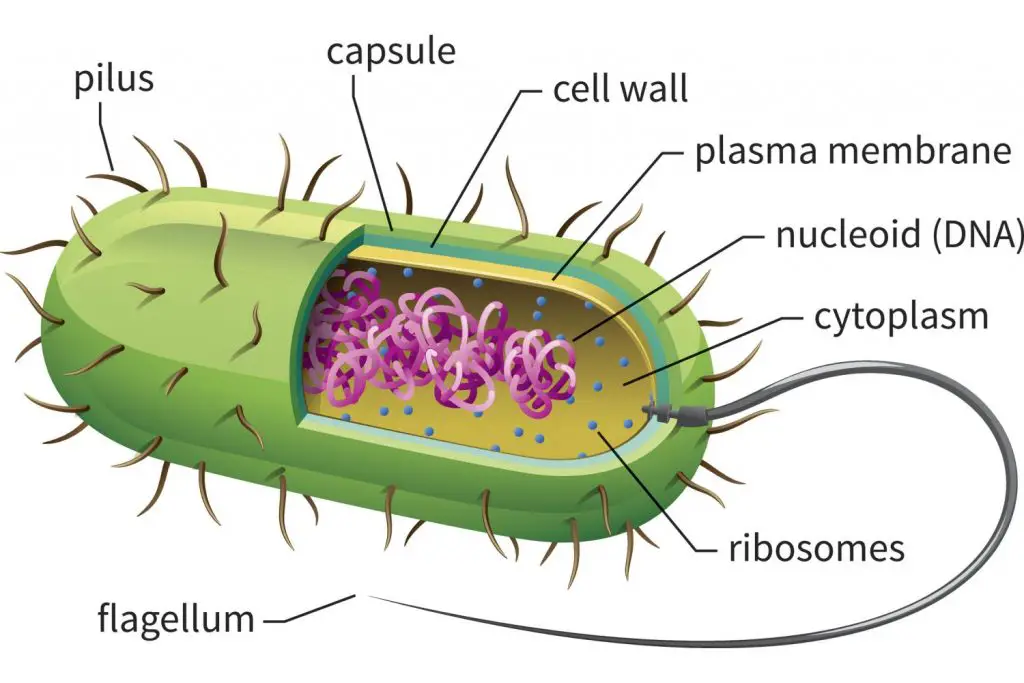
Prokaryotic Cell size
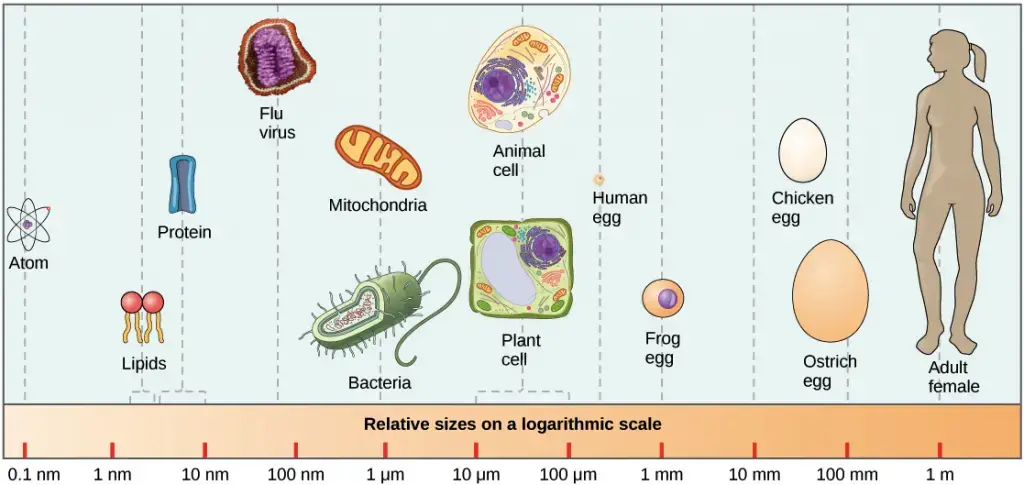
Prokaryotic cell size is a critical aspect of their biology, dictating their functional efficiency and interactions with the environment. These cells typically exhibit a size range that distinguishes them from their eukaryotic counterparts.
Prokaryotic Cell Size Range: The typical prokaryotic cell is characterized by its small size, with diameters ranging between 0.1 and 5.0 micrometers (μm). This size range places prokaryotic cells in a distinctly smaller category when compared to eukaryotic cells, which can have diameters ranging from 10 to 100 micrometers.
Surface-Area-to-Volume Ratio: One of the fundamental factors influencing prokaryotic cell size is the surface-area-to-volume ratio. As prokaryotic cells enlarge, their surface area and volume increase at different rates. The surface area increases with the square of the cell’s linear dimensions, while the volume increases with the cube of the same dimensions.
This phenomenon is illustrated using the example of a cube-shaped cell. When the dimensions of the cube increase, the surface area grows rapidly, whereas the volume increases even more substantially. Consequently, the surface-area-to-volume ratio decreases as the cell becomes larger.
Significance of Surface-Area-to-Volume Ratio: The surface-area-to-volume ratio is of paramount importance because it directly affects the cell’s ability to interact with its environment. The plasma membrane, which encloses the cell, serves as the interface through which the cell exchanges nutrients, gases, and waste products with its surroundings.
If a cell grows too large, its membrane may not possess sufficient surface area to support the necessary exchange of materials to sustain metabolic processes. The decreased surface-area-to-volume ratio can hinder the cell’s ability to absorb essential nutrients and eliminate waste efficiently.
Adaptations and Solutions: Prokaryotic cells have evolved various adaptations to mitigate the challenges posed by their small size and surface-area-to-volume constraints. Some cells adopt thin, elongated shapes or feature numerous surface protrusions, which effectively increase their surface area relative to volume. These adaptations enhance their capacity for nutrient uptake and waste removal.

In conclusion, prokaryotic cell size is a critical determinant of their functional capabilities. Their small size is a consequence of the surface-area-to-volume ratio, which impacts their ability to exchange materials with their environment. While prokaryotic cells have evolved strategies to overcome size-related challenges, these constraints continue to shape their biology and ecological roles.
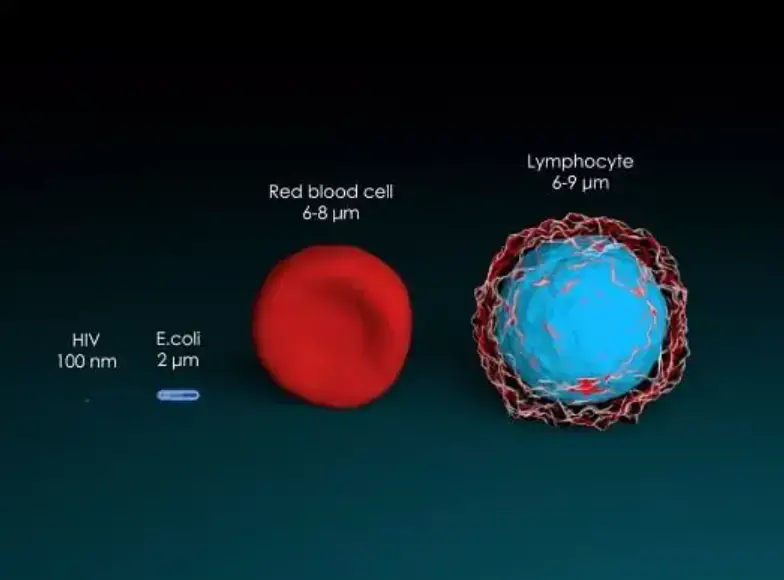
Morphology/Shape of Prokaryotic cells
Prokaryotic cells, particularly bacterial and archaeal cells, exhibit a diverse range of morphological shapes, reflecting their adaptability to various environmental niches. These shapes are essential for functions such as motility, nutrient acquisition, and interactions with other cells. The four most common morphological designs observed in prokaryotic cells are as follows:
- Cocci (Spherical or Ovoid): Cocci are prokaryotic cells that assume a spherical or ovoid shape. They appear as small, round structures under the microscope. The term “coccus” refers to a single spherical cell, while “cocci” is the plural form. Examples of cocci-shaped bacteria include Streptococcus and Staphylococcus. The spherical shape is advantageous for packing densely in colonies and can facilitate certain modes of cell division, such as binary fission.
- Bacilli (Cylindrical or Rod-Shaped): Bacilli are prokaryotic cells characterized by their elongated, cylindrical shape, often resembling rods. The singular form is referred to as “bacillus.” Bacilli are versatile in their adaptation to diverse environments. Examples include Escherichia coli (E. coli) and Bacillus subtilis. The rod shape allows for efficient nutrient acquisition and cellular mobility.
- Spiral Bacteria (Spirilla): Some prokaryotic cells exhibit a spiral or helical shape, earning them the classification of “spirilla” (singular, “spirillum”). These cells are elongated and can twist into various spiral configurations. Spiral bacteria are often motile and can move through liquid environments with a corkscrew-like motion. One well-known example is the genus Spirochaeta.
- Vibrio (Comma-Shaped): Vibrio-shaped bacteria are characterized by their curved or comma-like morphology. This shape allows them to move efficiently through liquid environments while maintaining a distinctive curvature. Vibrio cholerae, the bacterium responsible for cholera, is an example of a vibrio-shaped microorganism.
- Other Unique Shapes: In addition to the common morphological designs mentioned above, prokaryotic cells can assume other unique shapes depending on their species and environmental pressures. For instance, the archaeon Haloquadratum is known for its flat, square-shaped cells, which are adapted to the high-salt environments in which they thrive.
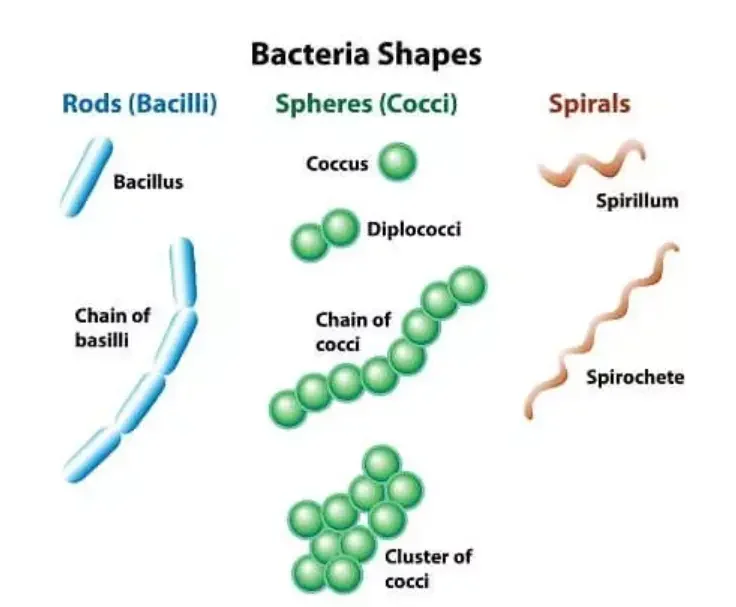
Prokaryotic cell morphology is a dynamic and adaptable trait influenced by genetic factors and environmental conditions. These various shapes play a crucial role in the survival, reproduction, and ecological interactions of prokaryotic organisms in diverse ecosystems.
Components of Prokaryotic Cells
Prokaryotic cells, characterized by their structural simplicity and the absence of a true nucleus, are comprised of several fundamental components that collectively enable their vital functions. These essential components of prokaryotic cells are as follows:
- Plasma Membrane: Serving as the outermost boundary, the plasma membrane is a lipid bilayer composed of phospholipid molecules. It envelops the entire cell and serves as a protective barrier that separates the cell’s internal environment from the external milieu. Furthermore, the plasma membrane is selectively permeable, controlling the ingress and egress of molecules, ions, and nutrients.
- Cytoplasm: The cytoplasm constitutes the cellular matrix that envelops all other components within the prokaryotic cell. This gel-like substance contains an array of solutes, including ions, small molecules, and macromolecules. It provides the medium in which biochemical reactions occur, and all cell organelles and structures are suspended within it.
- DNA (Genetic Material): Prokaryotic cells harbor their genetic material in the form of a single, circular DNA molecule. This DNA serves as the repository of genetic information that directs the synthesis of proteins and regulates the cell’s activities. It plays a central role in defining the characteristics and functions of the cell.
- Ribosomes: Prokaryotic cells possess ribosomes responsible for protein synthesis. These ribosomes are termed 70S ribosomes, distinguishing them from the 80S ribosomes found in eukaryotic cells. Ribosomes consist of ribosomal RNA (rRNA) and proteins, and they serve as the cellular machinery for translating genetic instructions into functional proteins.
In some prokaryotic cells, additional structures may be present:
- Cilia and Flagella: Certain prokaryotes possess cilia and flagella, which are whip-like appendages protruding from the cell surface. These structures facilitate cellular locomotion, allowing the cell to move through its environment. They are instrumental in navigating and responding to external stimuli.
In summary, the components of prokaryotic cells, while seemingly minimalistic in comparison to eukaryotic cells, are integral to the fundamental processes of life. The plasma membrane delineates the cell, the cytoplasm provides the milieu for cellular activities, DNA encodes genetic information, and ribosomes execute protein synthesis. These components collectively underpin the remarkable diversity and adaptability of prokaryotic life forms across diverse ecological niches.
Structure of a prokaryotic cell
The structure of a prokaryotic cell, while seemingly minimalist in comparison to its eukaryotic counterpart, possesses a remarkable array of components and intricacies that enable its fundamental biological functions. The principal elements of a prokaryotic cell’s structure are as follows:
- Capsule: Prokaryotic cells often feature a protective outer covering called the capsule, in addition to the cell wall. The capsule serves multifaceted roles, including moisture retention, safeguarding the cell against engulfment, and facilitating cell adhesion to nutrient sources and surfaces.
- Cell Wall: Positioned as the outermost layer, the cell wall bestows structural integrity and shape upon the prokaryotic cell. It is a hallmark feature, albeit with variability in composition among different species.
- Cytoplasm: The cytoplasm forms the gel-like interior of the cell, hosting an assortment of enzymes, salts, and cell organelles that orchestrate essential biochemical processes.
- Cell Membrane: Encircling the cytoplasm, the cell membrane serves as a semi-permeable barrier, regulating the ingress and egress of substances vital for cellular metabolism.
- Pili: Prokaryotic cells may extend hair-like appendages known as pili, which play a pivotal role in attaching to the surfaces of other bacterial cells, facilitating interactions and potential genetic exchange.
- Flagella: Flagella are elongated, whip-like structures responsible for cellular locomotion. They enable prokaryotic cells to move through their environments.
- Ribosomes: Prokaryotic cells house ribosomes, cellular structures pivotal for protein synthesis. These molecular machines translate genetic information into functional proteins.
- Plasmids: Plasmids are extrachromosomal, non-chromosomal DNA structures that exist within prokaryotic cells. They bear genetic information but are not directly involved in the process of reproduction.
- Nucleoid Region: In lieu of a membrane-bound nucleus, prokaryotic cells harbor their genetic material within a region of the cytoplasm known as the nucleoid. Here, the single, circular chromosome resides, directing the cell’s genetic operations.
It is noteworthy that prokaryotic cells eschew several organelles commonly found in eukaryotes, such as mitochondria, endoplasmic reticulum, and Golgi bodies. Nevertheless, they employ a prokaryotic cytoskeleton composed of proteins such as MreB and FtsZ, which, while more primitive than the eukaryotic cytoskeleton, contribute to cell shape and division.
Certain groups of prokaryotes, in addition to their rudimentary cellular components, also possess membranous organelles. These structures may serve specialized metabolic functions, such as photosynthesis or chemolithotrophy. Moreover, prokaryotic cells exhibit variability in size, typically ranging from 1 µm to 10 µm, although exceptions exist, spanning from 0.2 µm (e.g., Mycoplasma genitalium) to a striking 750 µm (e.g., Thiomargarita namibiensis).
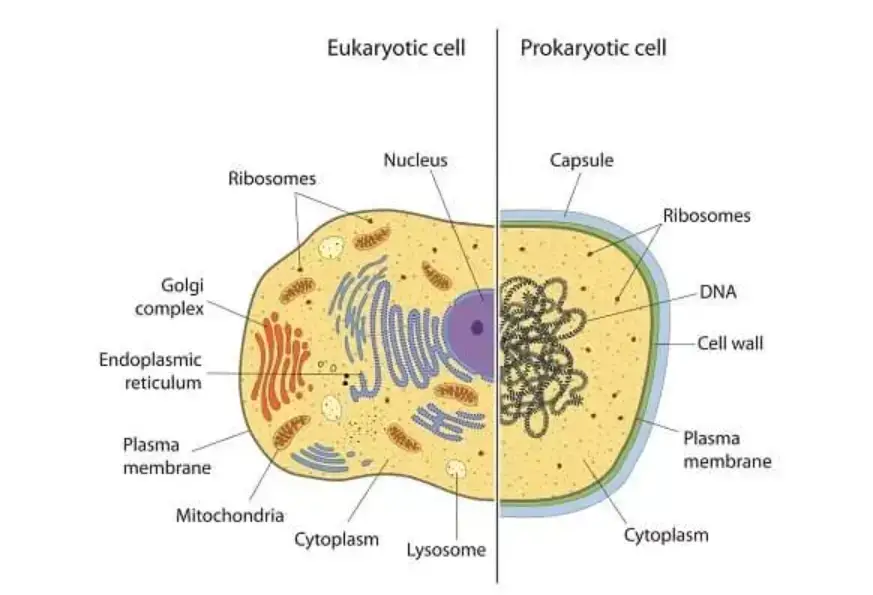
| Cell Component | Description |
|---|---|
| Capsule | Outer protective covering in some prokaryotic cells, aiding in moisture retention and cell adhesion. |
| Cell Wall | Outermost layer imparting structural integrity and shape to the cell. |
| Cytoplasm | Gel-like interior containing enzymes, salts, and cell organelles for biochemical processes. |
| Cell Membrane | Semi-permeable barrier regulating the entry and exit of substances. |
| Pili | Hair-like appendages facilitating attachment to other bacterial cells. |
| Flagella | Long whip-like structures enabling cellular locomotion. |
| Ribosomes | Cellular structures responsible for protein synthesis. |
| Plasmids | Extrachromosomal DNA structures bearing genetic information. |
| Nucleoid Region | Region in the cytoplasm housing the single, circular chromosome directing genetic operations. |
| Glycocalyx (In Some) | Glycoprotein-polysaccharide covering surrounding cell membranes. |
| Cytoplasmic Inclusions | Various inclusions like ribosomes scattered in the cytoplasmic matrix. |
In summary, the structure of a prokaryotic cell, while seemingly modest in comparison to eukaryotes, embodies an elegant and efficient design that underpins the diverse array of life forms that belong to this ancient and prolific category of organisms.
Prokaryotic Cell Diagram

Division of prokaryotic cells (Reproduction in Prokaryotes)
Reproduction in prokaryotic cells, characterized by their simplicity and lack of a true nucleus, occurs through two principal mechanisms: asexual reproduction via binary fission and sexual reproduction via conjugation, along with other processes known as recombination.
A. Asexual Reproduction (Binary Fission):
Binary fission is the predominant mode of asexual reproduction in prokaryotes and serves as a mechanism for the rapid proliferation of these microorganisms. The process unfolds in the following stages:
- DNA Replication: Reproduction commences with the replication of the prokaryotic cell’s singular, circular DNA molecule. This replication process yields two identical copies of the genetic material.
- Attachment to the Cell Membrane: The replicated DNA molecules attach to the cell membrane, positioning themselves within the cell.
- Cell Wall Expansion: The cell wall of the prokaryotic cell initiates an increase in size and moves inward. This spatial reconfiguration sets the stage for the division of the cell.
- Cell Division: Subsequently, a new cell wall forms between the two copies of DNA. This division results in the separation of the original cell into two genetically identical daughter cells. Each daughter cell inherits a copy of the DNA and other essential cellular components, ultimately becoming a fully functional prokaryotic cell.
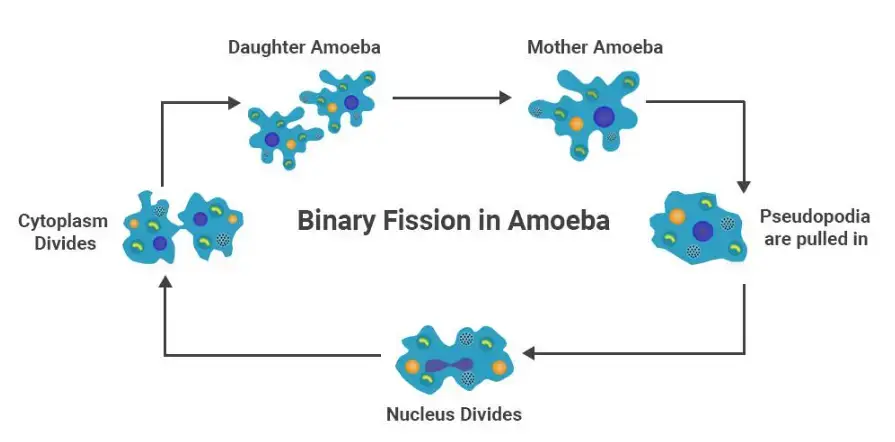
B. Sexual Reproduction (Conjugation, Transformation, Transduction):
Prokaryotes, despite their predominantly asexual mode of reproduction, can engage in sexual reproduction processes collectively referred to as recombination. These processes involve the exchange of genetic material between prokaryotic cells, often leading to increased genetic diversity. The three primary modes of recombination in prokaryotes are as follows:
- Conjugation: Conjugation is a process in which genetic material is transferred between two prokaryotic cells through a specialized structure called a pilus. The pilus serves as a bridge connecting the two cells, facilitating the transfer of genetic material from the donor cell to the recipient cell. This mechanism allows for the exchange of plasmids, small DNA fragments, or other genetic elements.
- Transformation: Transformation involves the uptake of DNA from the surrounding environment by a prokaryotic cell. The cell incorporates this exogenous DNA into its own genetic material, potentially introducing new genetic traits. Transformation is a crucial process in genetic research and has practical applications in biotechnology.
- Transduction: Transduction is a process wherein genetic material is transferred into a prokaryotic cell with the assistance of viruses, specifically bacteriophages. Bacteriophages infect prokaryotic cells and can package bacterial DNA fragments into their viral capsids during replication. When the bacteriophage subsequently infects another bacterial cell, it may inject the packaged DNA into the new host, leading to the incorporation of the foreign genetic material into the recipient cell’s genome.
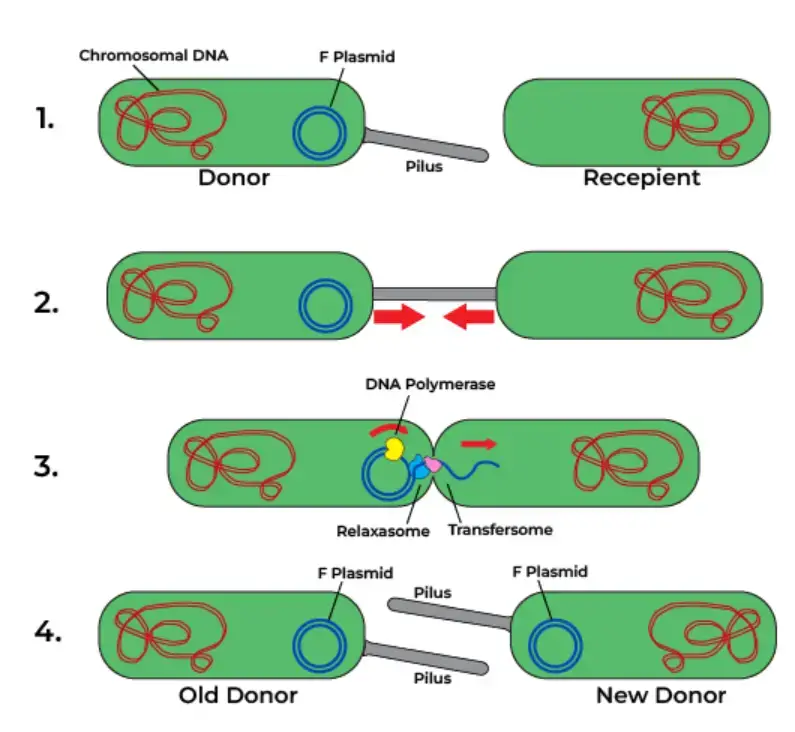
These mechanisms of recombination, including conjugation, transformation, and transduction, contribute to genetic diversity and adaptation in prokaryotic populations, allowing them to respond to environmental challenges and evolving conditions.
DNA transfer in Prokaryotic Cells
DNA transfer in prokaryotic cells is a fundamental process that plays a crucial role in the genetic diversity, adaptation, and evolution of microorganisms. This transfer primarily occurs in bacteria and archaea, although it has been extensively studied in bacterial systems. Three main processes facilitate DNA transfer in prokaryotic cells:
- Bacterial Virus (Bacteriophage)-Mediated Transduction: Transduction is a process where bacterial genes are transferred from one bacterium to another through the intermediary of a bacterial virus called a bacteriophage. This transfer is often considered an occasional error during the assembly of virus particles within the host bacterium. The bacteriophage’s genes, rather than bacterial genes, control the transfer of bacterial DNA during transduction.
- Plasmid-Mediated Conjugation: Conjugation is a well-studied mechanism for gene transfer in bacteria, with Escherichia coli being a notable example. This process is controlled by specific genes carried on plasmids, which are small, self-replicating DNA molecules within the bacterial cell. Conjugation involves the transfer of plasmid DNA from one bacterial host to another. Occasionally, during this process, a plasmid may integrate into the host bacterial chromosome, resulting in the transfer of part of the host bacterial DNA to another bacterium. This integration is considered an accidental event rather than an intentional adaptation.
- Natural Transformation: Natural bacterial transformation is a complex process that enables the transfer of DNA from one bacterium to another through the external medium. This mode of DNA transfer is unique because it relies on specific bacterial gene products that interact to facilitate the process. The transformation process requires the bacterial cell to enter a specialized physiological state known as competence. In Bacillus subtilis, for instance, approximately 40 genes are involved in the development of competence. DNA transferred during transformation can range from a portion to the entire bacterial chromosome. Unlike transduction and conjugation, natural transformation is a bacterial adaptation for DNA transfer and genetic exchange. A total of 67 prokaryotic species have been identified as naturally competent for transformation.
In archaea, the mechanisms of DNA transfer are less well understood but exhibit unique characteristics. For example, Halobacterium volcanii forms cytoplasmic bridges between cells that are believed to facilitate DNA transfer. Additionally, Sulfolobus solfataricus transfers DNA between cells through direct contact, and exposure to DNA-damaging agents induces cellular aggregation, potentially enhancing DNA transfer and repair processes.
DNA transfer in prokaryotic cells is a dynamic and complex phenomenon that contributes to the genetic diversity and adaptability of these microorganisms. Understanding the mechanisms of DNA transfer is essential for unraveling the evolutionary processes and ecological interactions of prokaryotic organisms in various environments.
Examples of Prokaryotic Cells
Prokaryotic cells encompass a diverse array of microorganisms that inhabit a multitude of environments across the planet. Two prominent examples of prokaryotic cells are bacterial cells and archaeal cells. These cellular entities exhibit unique characteristics and adaptations that enable their survival and proliferation.
1. Bacterial Cells: Bacterial cells are ubiquitous unicellular organisms that thrive in a wide range of habitats, spanning from terrestrial ecosystems like soil to the intricate milieu of the human body. They exhibit remarkable diversity in terms of their shapes and structures, contributing to their adaptability. Several defining features of bacterial cells include:
- Peptidoglycan Cell Wall: The cell wall of bacterial cells is primarily composed of peptidoglycan, a structural polymer that imparts rigidity and protection to the cell. This distinctive cell wall composition distinguishes bacteria from other microorganisms.
- Unique Structures: Bacteria possess a repertoire of unique structures such as pili, which facilitate attachment to surfaces and other cells, flagella for motility, and capsules that contribute to virulence and immune evasion.
- Extrachromosomal DNA (Plasmids): Bacterial cells often harbor extrachromosomal DNA elements known as plasmids. Plasmids carry accessory genes that can confer advantageous traits, such as antibiotic resistance or the ability to metabolize specific compounds.
- Endospore Formation: In response to unfavorable conditions, some bacteria possess the remarkable ability to form endospores. These are highly resistant, dormant structures that enable bacteria to endure harsh environments. When conditions become favorable again, endospores can germinate, giving rise to active bacterial cells.
2. Archaeal Cells: Archaeal cells, often referred to as archaebacteria, share characteristics with both bacteria and eukaryotes but represent a distinct group of prokaryotes. They are notable for their prevalence in extreme environments, including hot springs, acidic or alkaline environments, and even within the human body. Key attributes of archaeal cells include:
- Cell Wall Composition: While archaeal cells possess cell walls similar to bacteria, their cell wall composition notably lacks peptidoglycan. Instead, archaeal cell walls may contain other unique polymers such as pseudopeptidoglycan or S-layers.
- Membrane Lipids: Archaeal cell membranes are characterized by lipid molecules with a distinct stereochemistry, setting them apart from both bacterial and eukaryotic membranes. These unique lipids contribute to the stability and integrity of archaeal cell membranes in extreme conditions.
- Genetic Material: Archaea, like bacteria, typically contain a single circular chromosome that encodes essential genetic information. Additionally, they may carry plasmids, akin to bacterial cells.
In summary, bacterial and archaeal cells exemplify the adaptability and resilience of prokaryotic life forms. Their ability to inhabit diverse ecosystems and thrive in extreme conditions underscores their significance in the microbial world and their contributions to various ecological and biological processes.
3. Cyanobacteria (Blue-Green Algae): Cyanobacteria are a group of prokaryotic microorganisms that exhibit characteristics of both bacteria and photosynthetic eukaryotic algae. They are commonly found in aquatic environments, including freshwater lakes, ponds, and oceans, as well as in terrestrial habitats like moist soils and rocks. Key features of cyanobacterial cells include:
- Photosynthetic Capability: Cyanobacteria possess pigments, including chlorophyll, allowing them to conduct photosynthesis. They are often considered primary producers in aquatic ecosystems, as they convert sunlight into organic compounds and release oxygen as a byproduct.
- Cell Wall: Similar to other bacteria, cyanobacteria have a cell wall, but it lacks peptidoglycan and instead consists of a complex mix of polysaccharides and glycolipids.
- Colonial Growth: Some cyanobacteria exhibit colonial growth patterns, forming multicellular structures. These colonies can take on various shapes and may be responsible for the formation of microbial mats in aquatic environments.
- Nitrogen Fixation: Certain cyanobacteria have the remarkable ability to convert atmospheric nitrogen gas (N2) into ammonia (NH3), a process known as nitrogen fixation. This capability contributes to nitrogen cycling in ecosystems.
4. Mycoplasma: Mycoplasma are unique prokaryotic microorganisms known for their minimalistic cellular structures and a lack of a rigid cell wall. They are often referred to as “cellular parasites” because they inhabit host organisms, including humans and animals, causing various infections and diseases. Notable characteristics of Mycoplasma cells include:
- Lack of Cell Wall: Mycoplasma cells are distinct in that they lack a conventional cell wall. Instead, they are enclosed by a flexible plasma membrane, which contributes to their pleomorphic (variable) shapes.
- Small Genome: Mycoplasma genomes are among the smallest of all free-living organisms, containing only a minimal set of genes necessary for survival and parasitism.
- Host Associations: Mycoplasma species are known to infect a wide range of hosts, including humans, animals, and plants. They are responsible for various diseases, such as respiratory infections, genital tract infections, and plant diseases.
- Antibiotic Resistance: Some Mycoplasma species have developed resistance to antibiotics, posing challenges in the treatment of infections caused by these microorganisms.
These additional examples underscore the diversity and adaptability of prokaryotic cells in various ecological niches and their significant roles in both beneficial and pathogenic interactions with other organisms.
Quiz Practice
- What is a defining characteristic of prokaryotic cells?
A) Presence of a true nucleus
B) Presence of membrane-bound organelles
C) Circular DNA
D) Multicellularity
- Which domain includes prokaryotic organisms such as bacteria and archaea?
A) Eukaryota
B) Bacteria
C) Archaea
D) Protista
- What is the role of the nucleoid region in a prokaryotic cell?
A) Protein synthesis
B) Energy production
C) Reproduction
D) DNA storage and organization
- Which prokaryotic cell shape is characterized by a comma-like structure?
A) Cocci
B) Bacilli
C) Spiral bacteria
D) Vibrio
- What is the primary function of a prokaryotic cell’s plasma membrane?
A) Nutrient storage
B) Energy production
C) Regulating the passage of substances
D) DNA replication
- Which process involves the transfer of bacterial genes through a protein tube structure?
A) Transduction
B) Conjugation
C) Transformation
D) Replication
- What is the primary role of bacteriophages in prokaryotic gene transfer?
A) Bacterial adaptation
B) DNA replication
C) Transduction
D) Nutrient uptake
- Which prokaryotic gene transfer process relies on a physiological state called competence?
A) Transduction
B) Conjugation
C) Transformation
D) Replication
- What is the primary function of natural transformation in prokaryotic cells?
A) Bacterial adaptation
B) DNA repair
C) Nutrient uptake
D) Waste elimination
- In which prokaryotic domain is Halobacterium volcanii known for forming cytoplasmic bridges for DNA transfer?
A) Bacteria
B) Archaea
C) Eukaryota
D) Protista
Frequently Asked Questions
What is the difference between prokaryotic and eukaryotic cells?
The primary distinction between these two types of organisms is that eukaryotic cells have a membrane-bound nucleus and prokaryotic cells do not.
What are prokaryotic cells?
Prokaryotic cells are the cells that do not have a true nucleus and membrane-bound organelles.
What is found in both prokaryotic and eukaryotic cells?
Ribosome. Prokaryotes and eukaryotes are the two different types of cells. Eukaryotic cells contain membrane-bound organelles, such as the nucleus, endoplasmic reticulum, mitochondria while prokaryotic cells do not but the ribosome is the only organelle that can be seen in both prokaryotic and eukaryotic cells. Prokaryotic and eukaryotic ribosomes perform the same functions that is protein synthesis, however, eukaryotic ribosomes are much larger than prokaryotic ones.
What do eukaryotic cells have that prokaryotic cells do not?
The primary distinction between these two types of organisms is that eukaryotic cells have a membrane-bound nucleus and prokaryotic cells do not. The nucleus is where eukaryotes store their genetic information.
Which cell structures are seen in prokaryotic and eukaryotic cells?
Both prokaryotic and eukaryotic cells have structures in common. All cells have a plasma membrane, ribosomes, cytoplasm, and DNA. The plasma membrane, or cell membrane, is the phospholipid layer that surrounds the cell and protects it from the outside environment.
Which of the following attributes is common to both prokaryotic cells and eukaryotic cells?
Plasma membrane, ribosomes, cytoplasm, and DNA.
Which of the following statements is incorrect regarding prokaryotic cells?A) Their DNA is not enclosed within a membrane.B) They lack membrane-enclosed organelles.C) They typically have a circular chromosome.D) They reproduce by binary fission.E) They lack a plasma membrane.
Ans: E) They lack a plasma membrane.
How do prokaryotic cells divide?
The usual method of prokaryote cell division is termed binary fission. The prokaryotic chromosome is a single DNA molecule that first replicates, then attaches each copy to a different part of the cell membrane. When the cell begins to pull apart, the replicate and original chromosomes are separated.
Where do transcription and translation occur in prokaryotic cells?
Prokaryotic transcription occurs in the cytoplasm alongside translation.
Which of the following is a major difference between prokaryotic cells and eukaryotic cells?
The primary distinction between these two types of organisms is that eukaryotic cells have a membrane-bound nucleus and prokaryotic cells do not.
What are examples of prokaryotic cells?
Examples of prokaryotes are blue-green algae, bacteria and mycoplasma. Among prokaryotes, bacteria are the most common and multiply very fast.
What are the similarities between prokaryotic and eukaryotic cells?
Three similarities between prokaryotic and eukaryotic cells are that both have vesicles, vacuoles, and the ability to carry out the eight functions of life. Prokaryotes do not have organelles.
Which of the following is not found in prokaryotic cells?
Prokaryotes lack a defined nucleus (which is where DNA and RNA are stored in eukaryotic cells), mitochondria, ER, golgi apparatus, and so on. In addition to the lack of organelles, prokaryotic cells also lack a cytoskeleton.
Which of the following involves metabolic cooperation among prokaryotic cells?A) BiofilmsB) Binary fissionC) Endospore formationD) Endotoxin releaseE) Photoautotrophy
A) Biofilms
Biofilms involve metabolic cooperation among prokaryotic cells. In biofilms, multiple prokaryotic cells adhere to surfaces and form a complex, multicellular community. Within these biofilms, different cells can perform various metabolic functions, such as nutrient uptake, waste removal, and the production of extracellular substances that provide structural support to the community. This cooperative metabolic activity is a key characteristic of biofilm formation.
What do prokaryotic cells lack?
Prokaryotes lack a defined nucleus (which is where DNA and RNA are stored in eukaryotic cells), mitochondria, ER, golgi apparatus, and other membrane bound organelles. In addition to the lack of organelles, prokaryotic cells also lack a cytoskeleton.
- Text Highlighting: Select any text in the post content to highlight it
- Text Annotation: Select text and add comments with annotations
- Comment Management: Edit or delete your own comments
- Highlight Management: Remove your own highlights
How to use: Simply select any text in the post content above, and you'll see annotation options. Login here or create an account to get started.